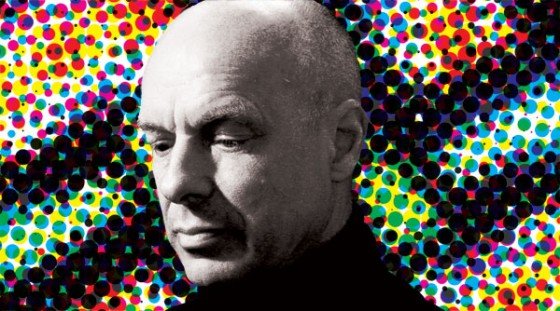Creative Practice Tips from Brian Eno
Brian Eno
Current neuroscience research confirms what creatives intuitively know about being innovative: that it usually happens in the shower. After focusing intently on a project or problem, the brain needs to fully disengage and relax in order for a “Eureka!” moment to arise. It’s often the mundane activities like taking a shower, driving, or taking a walk that lure great ideas to the surface. Composer Steve Reich, for instance, would ride the subway around New York when he was stuck.
Science journalist Jonah Lehrer, referencing a landmark neuroscience study on brain activity during innovation, writes:
“The relaxation phase is crucial. That’s why so many insights happen during warm showers. … One of the surprising lessons of this research is that trying to force an insight can actually prevent the insight.”
The ebb and flow of concentrated focus and total disengagement has been a subject of particular interest to the composer, musician, and producer Brian Eno (U2, Talking Heads, Roxy Music). Drawing on interviews from throughout Eno’s career, Eric Tamm’s book, Brian Eno: His Music and The Vertical Sound of Color, delves deeply into Eno’s “creative process.” Eno himself calls it:
...a practice of some kind ... It quite frequently happens that you’re just treading water for quite a long time. Nothing really dramatic seems to be happening. … And then suddenly everything seems to lock together in a different way. It’s like a crystallization point where you can’t detect any single element having changed. There’s a proverb that says that the fruit takes a long time to ripen, but it falls suddenly ... And that seems to be the process.
While neuroscience hasn’t yet been able to develop a foolproof scientific system to spark creativity, an artistic practice, if developed, can grease the wheels for more frequent and higher quality creative moments. As Eno puts it:
“The point about working is not to produce great stuff all the time, but to remain ready for when you can.”
He continues:
"There’s no point in saying, ‘I don’t have an idea today, so I’ll just smoke some drugs.’ You should stay alert for the moment when a number of things are just ready to collide with one another... The reason to keep working is almost to build a certain mental tone, like people talk about body tone. You have to move quickly when the time comes, and the time might come very infrequently – once or twice a year, or even less."
Craft, he says, “enables you to be successful when you’re not inspired.”
He goes on:
"The difficulty of always feeling that you ought to be doing something is that you tend to undervalue the times when you’re apparently doing nothing, and those are very important times. It’s the equivalent of the dream time, in your daily life, times when things get sorted out and reshuffled. If you’re constantly awake work-wise you don’t allow that to happen. One of the reasons I have to take distinct breaks when I work is to allow the momentum of a particular direction to run down, so that another one can establish itself."
Throughout his career, Eno has used a grab bag of tools to assist the creative process.
“There are lots of ways that you can interfere with it and make it more efficient.”
Freeform capture. Grab from a range of sources without editorializing. According to Tamm, one of Eno’s tactics “involves keeping a microcassette tape recorder on hand at all times and recording any stray ideas that hit him out of the blue – a melody, a rhythm, a verbal phrase.” He’ll then go through and look for links or connections, something that can form the foundation for a new piece of music.
Blank state. Start with new tools, from nothing, and toy around. For example, Eno approaches this by entering the recording studio with no preconceived ideas, only a set of instruments or a few musicians and “just dabble with sounds until something starts to happen that suggests a texture.” When the sound texture evokes a memory or emotion that impression then takes over in guiding the process.
Deliberate limitations. Before a project begins, develop specific limitations. Eno’s example: “this piece is going to be three minutes and nineteen seconds long and it’s going to have changes here, here and here, and there’s going to be a convolution of events here, and there’s going to be a very fast rhythm here with a very slow moving part over the top of it.”
Opposing forces. Sometimes it’s best to generate a forced collision of ideas. Eno would “gather together a group of musicians who wouldn’t normally work together.” Dissimilar background and approaches can often evoke fresh thinking.
Creative prompts. In the ‘70s Eno developed his Oblique Strategies cards, a series of prompts modeled to disrupt the process and encourage a new way of encountering a creative problem. On the cards are statements and questions like: “Would anybody want it?” “Try faking it!” “Only a part, not the whole.” “Work at a different speed.” “Disconnect from desire.” “Turn it upside down.” “Use an old idea.” These prompts are a method of generating specifics, which most creatives respond favorably to.
In the end, don’t underestimate your personal feelings about a project. Eno states: “Nearly all the things I do that are of any merit at all start off as just being good fun.”Further reading on related subjects
Originally published over at the 99 %.
Scott McDowell works with business leaders and creative teams to ease collaboration. He's also a DJ at WFMU. Follow Scott @mcd_owell
.

